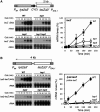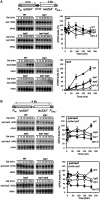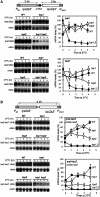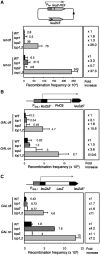Topological constraints impair RNA polymerase II transcription and causes instability of plasmid-borne convergent genes
- PMID: 21998294
- PMCID: PMC3273821
- DOI: 10.1093/nar/gkr840
Topological constraints impair RNA polymerase II transcription and causes instability of plasmid-borne convergent genes
Abstract
Despite the theoretical bases for the association of topoisomerases and supercoiling changes with transcription and replication, our knowledge of the impact of topological constraints on transcription and replication is incomplete. Although mutation of topoisomerases affects expression and stability of the rDNA region it is not clear whether the same is the case for RNAPII transcription and genome integrity in other regions. We developed new assays in which two convergent RNAPII-driven genes are transcribed simultaneously. Plasmid-based systems were constructed with and without a transcription terminator between the two convergent transcription units, so that the impact of transcription interference could also be evaluated. Using these assays we show that Topos I and II play roles in RNAPII transcription in vivo and reduce the stability of RNAPII-transcribed genes in Saccharomyces cerevisiae. Supercoiling accumulation in convergent transcription units impairs RNAPII transcription in top1Δ strains, but Topo II is also required for efficient transcription independent of Topo I and of detectable supercoiling accumulation. Our work shows that topological constraints negatively affect RNAPII transcription and genetic integrity, and provides an assay to study gene regulation by transcription interference.
Figures








Similar articles
-
Topoisomerase II is required for the production of long Pol II gene transcripts in yeast.Nucleic Acids Res. 2012 Sep;40(16):7907-15. doi: 10.1093/nar/gks626. Epub 2012 Jun 19. Nucleic Acids Res. 2012. PMID: 22718977 Free PMC article.
-
Transcriptional supercoiling boosts topoisomerase II-mediated knotting of intracellular DNA.Nucleic Acids Res. 2019 Jul 26;47(13):6946-6955. doi: 10.1093/nar/gkz491. Nucleic Acids Res. 2019. PMID: 31165864 Free PMC article.
-
Impairment of replication fork progression mediates RNA polII transcription-associated recombination.EMBO J. 2005 Mar 23;24(6):1267-76. doi: 10.1038/sj.emboj.7600602. Epub 2005 Mar 3. EMBO J. 2005. PMID: 15775982 Free PMC article.
-
DNA topoisomerases: nature's solution to the topological ramifications of the double-helix structure of DNA.Harvey Lect. 1985-1986;81:93-110. Harvey Lect. 1985. PMID: 2833466 Review. No abstract available.
-
[DNA supercoiling and topoisomerases in Escherichia coli].Rev Latinoam Microbiol. 1995 Jul-Sep;37(3):291-304. Rev Latinoam Microbiol. 1995. PMID: 8850348 Review. Spanish.
Cited by
-
Topoisomerase II is required for the production of long Pol II gene transcripts in yeast.Nucleic Acids Res. 2012 Sep;40(16):7907-15. doi: 10.1093/nar/gks626. Epub 2012 Jun 19. Nucleic Acids Res. 2012. PMID: 22718977 Free PMC article.
-
Supercoiling in DNA and chromatin.Curr Opin Genet Dev. 2014 Apr;25(100):15-21. doi: 10.1016/j.gde.2013.10.013. Epub 2013 Dec 22. Curr Opin Genet Dev. 2014. PMID: 24584092 Free PMC article. Review.
-
Causes and consequences of RNA polymerase II stalling during transcript elongation.Nat Rev Mol Cell Biol. 2021 Jan;22(1):3-21. doi: 10.1038/s41580-020-00308-8. Epub 2020 Nov 18. Nat Rev Mol Cell Biol. 2021. PMID: 33208928 Review.
-
Transcription-replication coordination revealed in single live cells.Nucleic Acids Res. 2022 Feb 28;50(4):2143-2156. doi: 10.1093/nar/gkac069. Nucleic Acids Res. 2022. PMID: 35137218 Free PMC article.
-
Transcription and recombination: when RNA meets DNA.Cold Spring Harb Perspect Biol. 2014 Aug 1;6(8):a016543. doi: 10.1101/cshperspect.a016543. Cold Spring Harb Perspect Biol. 2014. PMID: 25085910 Free PMC article. Review.
References
-
- Champoux JJ. DNA topoisomerases: structure, function, and mechanism. Annu. Rev. Biochem. 2001;70:369–413. - PubMed
-
- Crooke E, Hwang DS, Skarstad K, Thony B, Kornberg A. E. coli minichromosome replication: regulation of initiation at oriC. Res. Microbiol. 1991;142:127–130. - PubMed
-
- Wang JC. Cellular roles of DNA topoisomerases: a molecular perspective. Nat. Rev. Mol. Cell. Biol. 2002;3:430–440. - PubMed
Publication types
MeSH terms
Substances
LinkOut - more resources
Full Text Sources
Molecular Biology Databases

